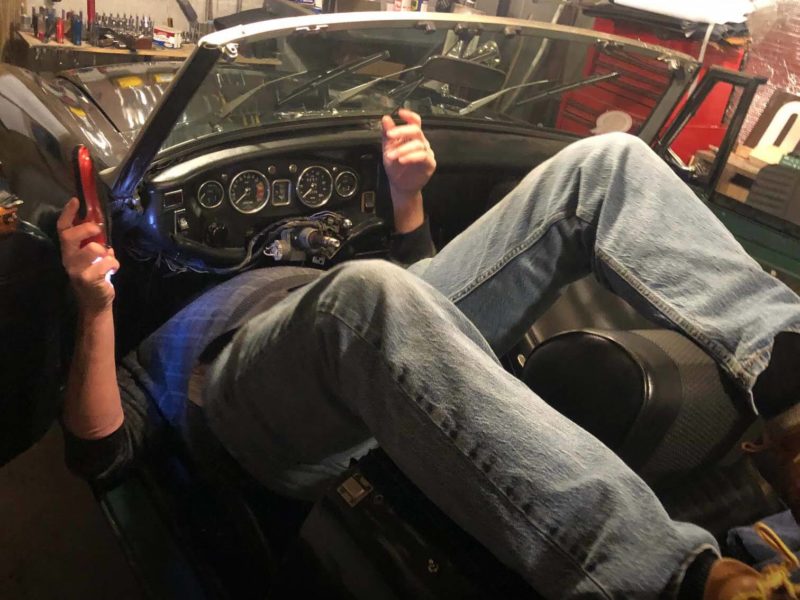Many years ago, when I was an impoverished college student, I “fixed” a kingpin problem on my MGA by replacing almost all of the front suspension with parts from an MGB. While I generally go to great lengths to try to preserve the originality of my cars (the local battery shop thinks I’m nuts for using two six-volt batteries instead of one twelve volt), I must admit that this swap has given me nearly 30 years of carefree motoring, and disc brakes to boot!
The junkyard MGB suspension I installed in the early ’70s finally wore out this year and I got a chance to re-examine my transplant when I rebuilt it. Since MGB parts are still much more common than MGA parts, there may be other MGA owners who, for whatever reason, would be interested in the details of this swap. One word of caution up front. Although the transplant is mostly bolt-on, it does require irreversible changes to your tie rods.
I began by finding a junkyard with a wrecked MGB and removing the front suspension. (You’ll probably need to do this yourself, as most junkyards tend to remove parts with a cutting torch, a process which does nothing to enhance the use-ability of the parts.) Make certain you take a jack and jack stands so you can remove parts safely. A hacksaw may be needed to cut the upper suspension bolts between the shock absorber and the trunnion, as these almost never drive out the way the manual says they will.
The lower A-frames on the MGA and MGB arc identical, so you can use whichever set is in better shape. Substitute the entire MGB swivel assembly, bearings, brake disc, and caliper assembly for the MGA parts. The springs used on MGAs and MGBs varied slightly from year to year and also between open and closed cars. I re-used the original MGA springs, as they were designed for the weight of my car. The bolt pattern for the MGA shock absorbers is slightly different than the pattern for the MGB shock absorbers, so use the MGA shocks for the upper suspension arm. (It is possible to file the holes in the MGB shocks until they fit, but I wouldn’t recommend this.) The MGB upper trunnion is slightly narrower than the MGA trunnion, so the longer bolt from the MGA upper suspension pivot must be used to span the MGA shock arms. There will be about a 1/4″ gap between the MGB trunnion and the MGA shock arms. A couple of heavy-duty washers will fill this gap nicely.
The bushings on the upper and lower trunnions and the A-frame mountings are wearing pares, and should be replaced with new bushings during this rebuild. (I used the more durable MGB V8 bushings.)
There are two parts which are not a straight bolt-on replacement between the MGA and MGB front suspension: the flexible brake hose and the tie rod ends. The threads on the MGB brake lines are different than those on the MGA, so the MGB brake hose which threads into the disc brake caliper will not connect directly to the MGA steel brake lines.
In the impetuousness of youth, I cut my MGA steel brake line shortly below the fitting that connects to the flex hose and spliced on the end of an MGB steel brake line using a compression fitting. Although this has worked fine for nearly 30 years, I would never recommend anyone splice a steel brake line! If I had it to do all over again, I would take a set of MGA and MGB flex hoses to a hydraulic shop and have them fabricate flex hoses with MGB fittings on the caliper end and MGA fittings on the end that connects to the steel line.
The other parts which need modification are the tie rods and tie rod ends. The steering lever on the MGB front swivel is positioned differently than the MGA steering lever, with the result that front wheels will be “toed-out” slightly if the front suspensions are swapped with no modifications. The solution, painful though it may be, is to cut a small section off the end of the tie rod to allow the tie rod end to be screwed in further to bring the “toe-in” back to the correct specification. This is obviously irreversible, so measure before you cut and do not cut off more than necessary! Assemble the complete suspension before you cut the tie rods, screw the toe-in adjustment in as far as it will go, and measure the toe-out to see how much needs to be cut off the tie rod ends. (The “string and eyeball”alignment check works line for this.)
As I recall, I had to cut about 1/2″ off my tie rods, but this was nearly 30 years ago, so do not trust my memory—measure the toe-out on your car. The steering needs to be centered when you take this measurement, with both tie rod ends screwed in as far as they will go, and you should find that both tie rod ends need to be trimmed by the same amount.
When you know how much needs to be removed, unscrew the tie rod from the tie rod end, leave the locknut on the tie rod then screw it back out of the way, and use a hacksaw to trim the required section off the end of the tie rod. Be careful to damage the threads as little as possible, clean up any burrs with a file, and then unscrew the locknut over the cut end, screwing it back and forth as needed to clean up the threads. Reassemble the tie rod ends, connect to the swivel assembly, and adjust the front end alignment. You will probably also need to cut about 1/2″ off the tie rod ends to make room for the lock nuts, since they will now screw further onto the tie rods. Bleed the brakes, and you’re ready to roll!







'Front Suspension' has no comments
Be the first to comment this post!